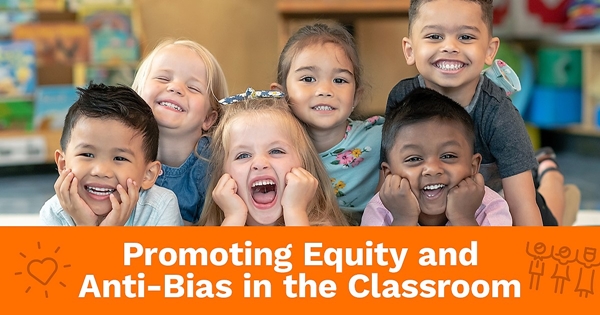Promoting Equity and Anti-Bias in the Classroom

In April 2019, the National Association for the Education of Young Children (NAEYC) adopted the Advancing Equity in Early Childhood Education Position Statement, highlighting strategies for all people to engage in anti-racist work, as well as strategies for stakeholders with direct impact in early childhood education, including early childhood educators. The statement asserts that “Early childhood educators… have a unique opportunity and obligation to advance equity…They can create early learning environments that equitably distribute learning opportunities…” (p.5).
With anti-racism work growing stronger and more collaborative, many early childhood educators are wondering what they can do to embrace this opportunity and fulfill this obligation. Below are steps that educators can start with as they work to build their classroom communities, focusing on the ways in which they set up their classroom environment, build relationships with children and families, plan for children’s learning, and engage in advocacy for fair practices for all children and families.
Promoting Equity and Anti-Bias in the Classroom Environment
-
Create a classroom environment where children see themselves.
This includes ensuring that children’s race, language, gender, family structure, interests, and more are reflected in the classroom décor and learning materials. Seek out and regularly utilize literature that is inclusive of the qualities of the children and their families in the class.
-
Cultivate an awareness of your own biases and consider how they impact your classroom expectations.
Acknowledge how these biases can impact your understanding of a child’s behavior, the ways in which you communicate with children and families, the expectations that you have for children and families in the classroom, and the ways in which you assess children’s development.
-
Create a reflection process that encourages you to evaluate classroom experiences and events through an equitable lens, both “in the moment” and in the long-term.
Teaching Tolerance offers a number of resources for teachers to begin this process, including Professional Development inviting teachers to test themselves for hidden biases, anecdotes of educators who have taken on this work in their practices, and a toolkit on reframing classroom management strategies through an anti-bias lens.
-
Collaborate with other educators and specialists to ensure that facets of the learning environment are appropriate for children’s individual needs.
Ensure that the classroom environment is responsive to sensory, health and safety, and other needs of individual children.
Promoting Equity and Anti-Bias in Relationships with Children and Families
-
Provide children and families the opportunity to learn about one another.
Recognize and address the bias that arises in the community (and in yourself, as an educator) related to culture, race, ability, religious beliefs, and more. Children and families should always feel respected, valued, visible, and noticed in the community.
-
Find out about the values, traditions, child-rearing practices, languages, and cultural expectations of each family.
This will help you to create a collaborative relationship with children and families as you create culturally responsive learning opportunities and goals for children at school.
-
Honor the experiences and cultures that children bring to the table as you explore the understandings that they’ve shaped.
Ask for questions and clarifications. Allow children to teach you, as the educator, about themselves.
-
Provide opportunities for children to make choices.
This promotes children’s agency. One early childhood education program describes ‘agency’ as being able to make choices and decisions to influence events and to have an impact on one’s world. To help build a child’s sense of agency, we should recognize that they are capable of initiating their own learning and empower them to make their own choices and decisions.
-
Utilize innovative methods of connecting with families.
A variety of approaches to family involvement will ensure that you are able to connect with the families of all of the children in your care.
-
Document and highlight the strengths of the children in your care on a consistent basis.
Pay attention to what children can do, rather than focusing on what they can’t do.
Promoting Equity and Anti-Bias in Learning Opportunities
-
Ensure that learning opportunities are tailored to the interests and abilities of the children in your class.
Take into account children’s development, cultural understandings, and means of communication as you plan for children’s learning experiences. Design learning experiences that utilize children’s home language(s) as this will also demonstrate a value of multilingualism.
-
Invite children and families to collaborate in the creation and implementation of learning activities.
Utilize the funds of knowledge that children and families bring into the classroom.
-
Work toward achievable learning goals with children.
Ensure that the learning experiences that you create for children are challenging, individually, to children, yet strengths-based and accessible. Support and encourage children as they work toward their learning goals, tailoring support to children’s individual needs.
-
Collaborate with other educators and specialists to maximize educational impact.
Ensure that learning activities are responsive to the specific needs of individual children.
-
Utilize equitable assessment processes.
Ensure that assessments of children’s abilities are linguistically accessible, and provide children authentic opportunities to demonstrate their skills. This could include collecting samples of children’s work to demonstrate progress over time, such as through portfolio work, assessing children’s skills through game play, and utilizing vocabulary in the child’s home language to ensure that understanding is reached. Assessment should never be a “one and done” endeavor, but rather an ongoing culmination of documentation of children’s skills and growth over time.
Promoting Equity and Anti-Bias Through Advocacy
-
Challenge racist and unfair policies and practices.
Critique learning standards, materials marketed for children, assessments, curricula, practices, and procedures. Respond to calls for feedback on “best practices”, position statements, and policies.
-
Collaborate with others committed to equity.
Engage in work with a professional association devoted to advancing equity, such as the National Association for the Education of Young Children. Build relationships with policymakers, and their offices, whose beliefs align with yours. Stay on top of policymakers whose beliefs may deviate, sharing data on the importance and benefits of change.
This type of work must be ongoing and constantly reevaluated, to ensure that the classroom is equitable for all children and families when they first join the classroom community, and as they (and you!) continue to grow within it.
Additional Resources for the Classroom
- Character Education Posters
- Around the World Poster Set
- Generations Poster Set
- Fathers Posters
- My Multicultural World Book Set
- Celebrate Diversity Book Set
- Diversity Today Book Set
- Families Board Book Set
- My Family Builders Set
- Multicultural Me Book Set
 Zaina Cahill, Early Childhood Education Policy Director at Children First, is a graduate of New York University (B.S. in ECE and Special Education) and Walden University (M.S.Ed. in Elementary Reading and Literacy), and has worked in a variety of capacities in the field of education working with toddler through elementary school children and their families, including children with special needs. In particular, Zaina has a passion for working to promote diversity, equity, and inclusion in the education environment. In Pennsylvania, Zaina holds Level 2 teaching certification in ECE, as well as PQAS (PA Quality Assurance System) certification to offer professional development. In addition, she is a certified CLASS observer (Infant, Toddler, PreK). Zaina is also adjunct faculty at Arcadia University, in the school’s graduate program for Early Childhood Education. Zaina is a member of the NAEYC Affiliate Advisory Council, the Exchange Leadership Institute, and the Philadelphia Race Matters and Cultural Competency Learning Circle. In 2016, Zaina was an honoree in attendance at the White House Teacher of the Year Event, hosted by Barack Obama, and has offered testimony in congressional hearings advocating for children and early childhood educators. In addition to presenting at various local, state, and national conferences, Zaina has also made a number of written contributions to blogs and education publications.
Zaina Cahill, Early Childhood Education Policy Director at Children First, is a graduate of New York University (B.S. in ECE and Special Education) and Walden University (M.S.Ed. in Elementary Reading and Literacy), and has worked in a variety of capacities in the field of education working with toddler through elementary school children and their families, including children with special needs. In particular, Zaina has a passion for working to promote diversity, equity, and inclusion in the education environment. In Pennsylvania, Zaina holds Level 2 teaching certification in ECE, as well as PQAS (PA Quality Assurance System) certification to offer professional development. In addition, she is a certified CLASS observer (Infant, Toddler, PreK). Zaina is also adjunct faculty at Arcadia University, in the school’s graduate program for Early Childhood Education. Zaina is a member of the NAEYC Affiliate Advisory Council, the Exchange Leadership Institute, and the Philadelphia Race Matters and Cultural Competency Learning Circle. In 2016, Zaina was an honoree in attendance at the White House Teacher of the Year Event, hosted by Barack Obama, and has offered testimony in congressional hearings advocating for children and early childhood educators. In addition to presenting at various local, state, and national conferences, Zaina has also made a number of written contributions to blogs and education publications.
The opinions, representations, and statements made within this guest article are those of the author and not of Becker’s School Supplies as a whole. Any copyright remains with the author and any liability with regard to infringement of intellectual property rights remain with them. The company accepts no liability for any errors, omissions or representations.
